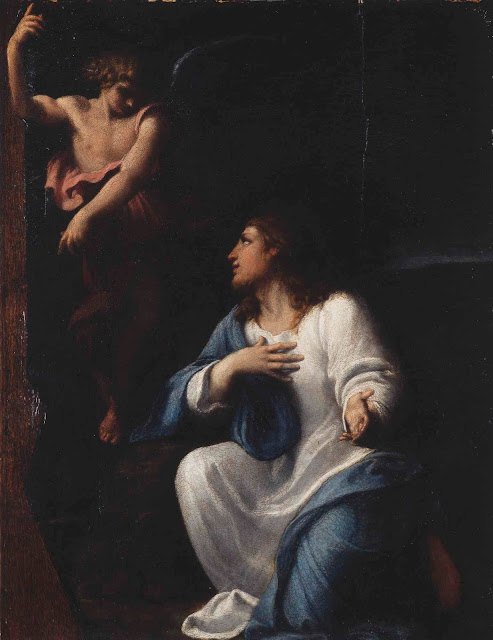 |
| Annibale Carracci (Bologna / Rome) Agony in the Garden ca. 1595-97 oil on panel Royal Collection, Windsor acquired by Charles I |
"Against a dark background the figure of Christ kneels, his head turned right towards the figure of an angel in the upper left of the painting. Christ holds his right hand to his breast and gesticulates outwards to the viewer with his left. The angel points upwards with his right hand and downwards to a small cross with his left. Although it has suffered, the picture is acceptable as Annibale's and probably dates from the period just before, or soon after, his arrival in Rome (c. 1595-7). When it was in the collection of Charles I the painting was engraved in reverse by Vorsterman. The engraving contains a considerable amount of detail which is not visible in the original painting, even after cleaning, including the figure of a sleeping Apostle behind the angel, heads of soldiers behind Christ, and a crown of thorns beside the cross on the left (this has possibly been cut away)."
– text by curators at the Royal Collection
 |
| Lucas Vorsterman after Annibale Carracci Agony in the Garden 1627 engraving British Museum |
"According to the lettering, this plate was made at the express command of Charles I after a painting in his own collection. The painting, now badly damaged, remains in the Royal Collection, and the attribution to Carracci is still generally accepted. The plate, being a commission, itself entered Charles's collection, and is recorded in van der Doort's inventory, which also states that the painting itself was hanging in the Queen's house in Greenwich. The painting is very small – exactly the same size as the print – and this, as well as its Catholic piety which doubtless appealed to the Queen, may have been the reason why it was chosen to be engraved."
– text by Antony Griffiths from The Print in Stuart Britain (British Museum, 1998)
 |
| Barthélémy d'Eyck (Netherlands / France) Still-life with books in niche ca. 1442-45 oil on panel Rijksmuseum, Amsterdam |
 |
| Jacobello del Fiore (Venice) Martyrdom of St Lawrence with two Benedictine nuns ca. 1425 tempera on panel Rijksmuseum, Amsterdam |
"Jacobello, who had previously worked in various small Italian cities, was among the first to introduce the elegant and brightly colored 'international Gothic' style to Venice. The two kneeling nuns at left, who are witnesses to this scene of martyrdom, would have commissioned the picture for their private devotion; they perhaps belonged to the Venetian convent of San Lorenzo."
– text by curators at the Rijksmuseum
 |
| Anonymous painter Portrait of unknown woman ca. 1550-74 oil on panel Rijksmuseum, Amsterdam |
 |
| Anonymous painter working in Ferrara Magnanimity of Alexander the Great ca. 1475-1500 tempera on panel Hermitage, Saint Petersburg |
 |
| Agnolo Gaddi (Florence) The Feast of Herod 1387 tempera on panel Louvre |
 |
| attributed to Bernardino Licinio (Venice) Portrait of a man with a puzzle ca. 1520-30 oil on panel Royal Collection, Windsor |
"An unknown man is shown bust-length, facing slightly to the left, with his head tilted to the right against a blue-grey background. He is wearing a black hat and a black coat, open at the neck to reveal a white shirt, and in his hands he holds a child's toy, a puzzle trick known as 'flick-flack'. It consists of three or more rectangles of wood, held together by tapes in such a manner that small object placed under the tapes may be made to vanish. This inscription on the toy is not original, but the sitter's intense facial expression and the strangeness of the attribute suggest that a specific meaning is intended, perhaps of mortality."
– text by curators at the Royal Collection
 |
| circle of Adam Elsheimer (Germany) Forest 16th century oil on panel Hermitage, Saint Petersburg |
 |
| Pieter Neefs the Elder (Flanders) Interior of a Gothic Church 1649 oil on panel Hermitage, Saint Petersburg |
 |
| Anton Raphael Mengs (Germany) Parnassus ca. 1760 oil on panel Hermitage, Saint Petersburg |
Anton Raphael Mengs painted the panel above in preparation for a near-identical ceiling-fresco of 1761, commissioned by Cardinal Alessandro Albani for his palace in Rome. Partisans of the neoclassical Mengs believed they were witnessing the resurrection of Raphael's grand manner after 150 years of neglect. Within a couple of generations, continuing shifts in taste removed whatever prestige had briefly attached itself to the Mengs version, leaving Raphael's reputation undisturbed.
 |
| Joseph Plepp (Switzerland) Still-life with cherries and cheese 1632 oil on panel Hermitage, Saint Petersburg |
 |
| Nicolaes Verkolje (Netherlands) Joseph and Potiphar's Wife before 1746 oil on panel Hermitage, Saint Petersburg |
 |
| Marcantonio Franceschini (Bologna) Virgin and Child with St John the Baptist and St Elizabeth before 1729 oil on panel Royal Collection, Windsor |
 |
| David Teniers (Flanders) Card players ca. 1645 oil on panel, transferred to canvas Hermitage, Saint Petersburg |